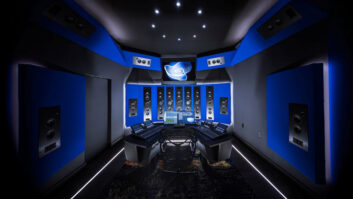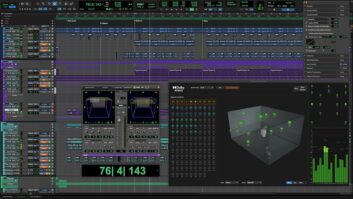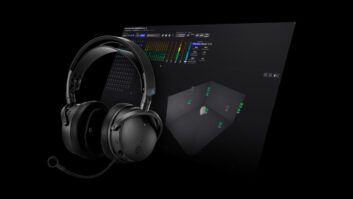
The passing of audio innovator Ray Dolby on September 12, 2013 at the age of 80 has resonated across the entire pro audio industry. An engineer whose name became synonymous with “good sound” for millions of consumers, Dolby was an enduring presence in the field. Here are just a few stories from those who crossed his path over the years—feel free to add your own in our Comments section below.
• • •
Rupert Neve – Rupert Neve Designs
In 1968, I supplied a large console to PYE RECORDS in London. They had various items of outboard gear already installed, amongst which were some items that I did not recognize. I was a little suspicious of unfamiliar gear. It was explained to me that this was noise reduction equipment.
Apparently someone had come up with an expansion/compression circuit that gave more than 10 dB of noise improvement in signal-to-noise ratio on tape. In those days, a good tape recording only reached a 58-60 dB noise floor. When copies were made, noise got progressively worse. A master tape was unusable; editing and reduction to a 2-track finished recording were mandatory.
The new equipment was made by a guy named Ray Dolby who had a small workshop in Battersea, London. His equipment used input and output transformers, and I was concerned that if his product was used on every track, it would impair the quality of my console sound. PYE recommended that I should go to see him.
I had lunch with Ray; he was a very friendly and knowledgeable engineer. He told me that the real money was to be made in the consumer market. He had developed a simple version of the professional gear. He held the opinion that it was more profitable to let others do the manufacturing and collect a royalty on the design.
I was very cynical. Cassette recorders were becoming popular and hundreds of unknown makers in the Far East were producing them. How was Ray ever going to discipline this market to appreciate the value of noise reduction and to line up to pay him for use of his circuit? I jokingly shook hands with him as we agreed that I would never compete on noise reduction if he would never build consoles. We always stuck to that.
Ray always remained friendly when we met at shows, etc. When I congratulated him on his success, he asked me how many legal staff I employed. He told me a few years ago that he employed 60 design engineers—but 120 lawyers!
• • •
Martin Porter – Executive Director, Sports Video Group
Thirty-five years ago, I was involved in a start-up magazine for recording studios. Those were the days when there actually were recording studios. And recordings were made on 2-inch tape, which was the source material for an historic generation of music that would have sounded a whole lot worse if it wasn’t for Ray Dolby.
Ray was the guy you saw walking around the AES Show—just an ordinary engineer playing with the gear and talking specs. He had his name on every tape machine on the planet but he wasn’t quite famous himself. In those days Dolby meant noise reduction—a push of a button took the horrible hiss out of the recording and playback. And this man behind the miracle was a great ‘get’ for a sound-struck, young journalist who was only doing the job so he could hang out where the music was being made — at the Hit Factory, the Record Plant, Sigma, Criteria, Muscle Shoals, etc.
Those were tape days for journalists too. I had a Sony cassette recorder with a suction-cup microphone that I used to tape all my phone interviews. I licked the suction cup, pressed it to the phone receiver, then pressed RECORD and let Ray tell his life story as a technical vagabond from England, to India and back to San Francisco; the early days of building the first tape machine at Ampex; and then something about his dream of a sound bigger than stereo —something he called surround. I confess that I don’t remember all the details of the piece and, sorry, I was unable to find that ancient issue of the magazine, Pro Sound News, in my shed. But here’s something nobody ever read.
The damn microphone had fallen off the phone receiver. The tape had the ultimate form of noise reduction — it was blank. I had taken up one hour of this engineering giant’s time and I had nothing to show for it. So I had a choice:
—Make the story up
—Or call him back
I got Ray Dolby back on the phone. I cracked a joke, waited for him to say he couldn’t talk, and then after a short laugh, he started talking all over again, as if he had taped the conversation himself in his head. He was a gentleman. Zero attitude. Happy to oblige. I taped and took written notes as back up this time.
I told this story recently to one of my editors who had a similar editorial mishap, as I’ve probably told it dozens of times before. It was my pat life lesson about how men of greatness can still be kind; that you’re never too busy to help someone who’s just getting started.
I even got a chance to tell the story to Ray himself.
Several years back, I was on a cab line at CES and was offered to share a ride. I hopped in the back seat and found myself sitting next to Ray Dolby, now a billionaire, now a brand name, now a legend. I introduced myself and he pretended he remembered who I was.
After a bit of trade show, new product chit-chat, of course, I told him my story, to which he reacted with a nod and a deadpan smile. I thanked him for helping out a young journalist, for not making me feel like an absolute fool, and for being so generous with his time and for just plain understanding. He nodded as if it was nothing and replied with playful grin:
“I must not have been very busy that day, huh?”
That was Ray Dolby—a decent, regular guy. He was just another engineer who woke up in the morning, put on his pants one leg at a time, and then went to work to make the world a better sounding place.
• • •
Garry Margolis, AES Treasurer
Ray and I had many interactions over the years.
In the late ’60s, we first met at an Audio Engineering Society convention in Los Angeles where he introduced and demonstrated his first product, the A301 S/N Stretcher, using what later became known as A-type Dolby noise reduction. He played a section of a Mahler symphony (a Decca/London recording) with no audible tape hiss and huge dynamic range, far greater than could be reproduced on a vinyl disc.
We had a minor disagreement about that recording. In an extremely quiet section at the end of the excerpt, there were several light taps on timpani. I thought I heard little bursts of tape noise along with the timp notes, but he said that they were sympathetic resonances from a snare drum. In either case, those artifacts would have been inaudible in playback.
I followed the development of Dolby noise reduction with great interest. B-type noise reduction for audio cassettes made them practical for home music reproduction, and I handled the production and commercial release of ethnic aka world music recorded in the field on cassette originals, something that was then unthinkable — Dolby B made it possible.
When he developed surround sound on optical film soundtracks using Dolby A noise reduction, I was very excited. I was then working in film sound and immediately realized its potential, but at that time, Dolby Laboratories was based in London with an office in New York; it had no presence in Hollywood or the West Coast, where they could have used a representative.
I wrote to their New York office in early 1974, recommending that they open an office in Hollywood and saying I was the perfect person to run that office. A couple of letters were exchanged, and I heard nothing more from them. I accepted a position with JBL, and, two weeks later, learned that they had, in fact, just opened an office in Hollywood and hired someone else to staff it. Then Star Wars was released — Dolby Surround went on to revolutionize cinema and, later, create the home theater industry.
Ray owned his company and invested two or three years in promoting the system before it made any significant inroads. If a public company and/or one run by a business school graduate had developed Dolby Surround, it would never had been adopted because of the time and investment required. It was his stubborn commitment that made it happen.
As a JBL staff member, I worked with Dolby Laboratories people on a number of projects and became friendly with them and with Ray. At an SMPTE trade show in New York, we were chatting at his display booth and I told him about my attempt to get hired. He smiled and pointed at a sign in his booth: “Application Engineers Wanted.” By that time, I was a JBL Vice President, so I thanked him and told him, “Sorry, too late.”
The state-of-the-art screening room in the Dolby San Francisco headquarters has a recess in one of the front walls where Ray’s nine-foot Steinway grand piano was stored. Ray occasionally played it — I’m not aware that anyone was invited to listen.
During a Los Angeles AES Convention, he was wearing an exhibitor badge and was denied entrance to a papers session by a student volunteer at the door who didn’t know who he was. He protested, but the student politely told him that he could upgrade his registration to gain admission, as she had been instructed. When she learned who he was, she was mortified and was then amazed when he came back later and apologized to her for putting her in that position. Not many people would have apologized.
A senior executive in the Dolby organization told me the following:
Some years ago, American Express ran a television advertising campaign featuring people like Jim Henson whose names or activities were well-known but whose faces were not — the slogan was “You don’t know me, but…” With the Dolby name ubiquitous on theater marquees and tape cassettes and players, Ray would have been the perfect spokesman.
The advertising agency for American Express offered him US$1,000,000 to appear in one of their ads. He declined the offer. He valued his privacy that much.
Our last contact was during the time that I was representing Philips’ interests in DVD-Video and Super Audio CD. In both areas, Philips was a head-to-head competitor with Dolby Labs. It was the general consensus that Super Audio CD sounded better than DVD-Audio, which uses technology for which Dolby Labs is the licensor. At an Audio Engineering Society reception in 2002, he asked me about this, and we had a lengthy discussion about the differences in filter design that might have affected these perception issues. There was no sense that we were competitors—it was an engineering discussion that I found illuminating and, I hope, he also did.
He stopped coming to AES activities, and, in reading this obituary, I’m saddened to learn that he developed Alzheimer’s. He was lost to the audio world some years before he died.
Ray was a remarkable engineer and a fine person.
• • •
Have your own story about Ray Dolby or using his technologies?
Share it below in the Comments Section!







